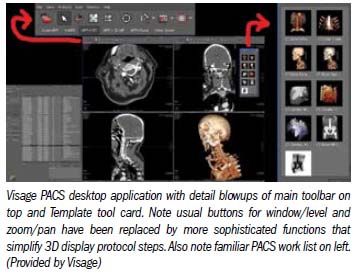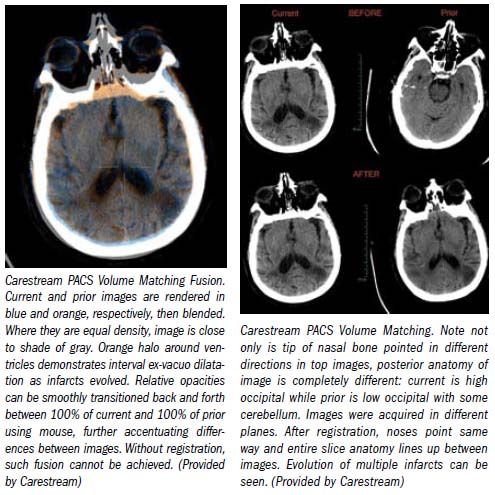2D PACS has had its day in the sun, now 3D PACS is moving in
For the past 15 years, most PACS have performed the basic tasks of taking in images, archiving them, sending them to workstations for display, and hopefully not losing them.
For the past 15 years, most PACS have performed the basic tasks of taking in images, archiving them, sending them to workstations for display, and hopefully not losing them. In the early days of PACS, in the late 1990s, that was considered plenty, given that the predecessor was film. Every system had the ability to zoom and pan and window and level. They could even flip and rotate images, which any picture managing software can do today. Measurement tools were also a given.
Over time, as CT scanners were able to slice thinner and thinner sections of the body, isometric data sets became available and the voxel (volume element) entered the vocabulary of medical imaging. It soon became apparent that new possibilities in manipulating the data to produce multiplanar reformations (MPRs) and maximum intensity projections (MIPs), as well as volume and surface renderings, could be realized.

These images have proven highly useful to the radiologist and referring clinician for both diagnosis and preoperative planning. But the software to perform these 3D renderings was often complex to use and typically found on only one or two separate computers in the department. To manipulate a set of images, they would have to be transferred to one of these workstations, and then someone, either a radiologist or a technician, would have to spend a fair amount of time adjusting the software to obtain a useful view of the data. Afterward, only a small set of key views would be captured and sent back to the PACS for archiving and review and the rest of the 3D model would be thrown away.
There was good reason for this. Radiologists used to look at about 30 slices of the head, about 60 slices of the chest, and about 80 slices of the abdomen and pelvis. This has not changed, even with the advent of multislice CT scanners. In fact, what most of these scanners do is acquire images in razor-thin slices, 0.5 or 0.6 mm, and average them together to make the typical 2.5-mm, 5-mm, or 10-mm–thick slices radiologists are used to seeing. So what was the point of making devices able to acquire the thin slices?
The answer is 3D. And that is why every CT vendor tries to package a 3D workstation with its scanner. It's not just because they want to sell you more; it's because it takes good 3D processing to bring out many of the benefits of the new scanners over older or less advanced ones. But as beautiful as the images are that the vendor may be able to produce on that workstation, it is still physically fixed in one location, typically. And more important, is not integrated with the PACS. Even if the workstation is accessible remotely, it is often disruptive to a radiologist to have to put PACS aside, push an exam to the 3D system, manipulate it there, and then push back to PACS only a few sample 2D captures of the 3D model.
ENTERPRISE DISTRIBUTION
There was a time in the mid-1990s when PACS vendors looked askance at enterprise distribution, the ability to serve out images as web pages to computers at nursing stations and doctors' homes and offices. Some of the bigger vendors thought that it was not important enough to modify a system they had designed to do the work of a radiology department. This led to the growth of several smaller companies that specialized in the enterprise distribution market.
At larger institutions these supplemented the PACS and at some smaller institutions they actually became the PACS. Some of those companies had the foresight to realize that if they didn't become full-blown PACS companies, they would not survive because the established PACS vendors would eventually absorb this niche product into their own. Indeed this has happened. What PACS vendor has no web distribution offering today? And how many companies are there today that offer just enterprise image distribution without PACS?
The same thing is happening with what is called 3D, or advanced visualization, technology. Yesterday's advanced visualization will be considered just visualization tomorrow. It is a natural evolution, and it has already happened in some PACS. More and more, PACS have incorporated not only the basic 3D manipulations of MPR and MIP, but also vessel tracing for angiographic studies, virtual endoscopic views for flying through hollow viscera like the trachea or intestines, and surface rendering for complex fractures such as those of the tibial plateau, including the ability to remove unwanted bones that obscure the view, like the femoral condyles.
Such features were considered the sole domain of 3D companies such as TeraRecon, Vital Images, and the former Voxar. These companies tended to offer simpler to use and sometimes more powerful advanced visualization tools than the CT vendors, but were still disconnected from the PACS. So PACS vendors began incorporating these advanced functions into their systems, and the degree of integration of this functionality is one of the key differentiators in the PACS market today. To that end, the market for stand-alone 3D systems will likely shrink as it, like enterprise distribution, gets assimilated into PACS.
One 3D vendor who has already seen this trend is Visage, which has worked to turn its strong server-based advanced visualization system into a PACS. Having the computer programming expertise to manipulate 3D models of hearts, brains, and everything else, it was fairly straightforward for them to add the other essential workflow elements of work lists and hanging protocols. And like any good 3D PACS vendor, standard 3D renderings are just another part of the hanging protocol, along with the pre- and postcontrast axial images. And like any good 3D vendor, their tools are simplified through the use of tool cards with big buttons that allow the radiologist to rapidly select which type of 3D rendering he wants to see, the same way he might pick a window and a level setting.
Since all of the 3D rendering is done on the server side instead of at the PACS workstation, the speed of the system does not depend on the processing power of the workstation. It will remain fast so long as not too many people are actively using it at the same time (the capacity is planned for ahead of time) and the network connectivity isn't too slow, at least about 2 MBps, which is within range of what most home cable and DSL users have.

Conversely, there is one longtime PACS vendor, Carestream, that has made serious leaps into the 3D space, and there is one 3D functionality it offers that no other PACS vendor has incorporated yet. It is called automatic image registration and it is a big deal. It is an underlying technology in the system that opens the door to comparisons in PACS that radiologists could only guesstimate before.
Whenever a patient is scanned in a CT scanner, the head, for example, is never in the same position. One time the nose may be pointed up and to the left, the next time pointed down and to the right. One of the primary tasks of a radiologist is to compare the current exam to the prior and judge if the bleed or the tumor has changed. But since the head is sliced differently each time it's scanned, we can only estimate the change in our mind's eye, so to speak, trying to account for the difference in patient positioning from exam to exam.
This a perfect place to use the thin slices of the CT scan, the ones that are too thin to be viewed individually, to reslice that data so the two scans line up with each other in 3D space: the nose in one scan points in exactly the same direction as in the other. For the first time, we can really compare two different scans matched up exactly, slice by slice, even though their orientations in 3D space were different at the time of acquisition.
With this foundation, new kinds of comparisons can be made that were previously impossible. Not only can the matched slices be compared side by side, they can even be overlaid on each other with different color maps. And a slider bar can be used to transition the opacity/transparency of one scan or the other, back and forth, to truly see if a brain tumor or lung nodule or kidney mass has changed in size.
Such overlays just never made sense before because the slices of two scans never really matched up with each other. This kind of image registration can be performed not only between two scans from the same modality, but with any other volumetrically acquired modality as well, such as PET or MRI. So a preoperative CT scan, for example, can be directly overlaid on a postoperative MRI.
Automatic image registration used to be found in research packages and even in some clinical 3D workstations. But for the first time it is now built directly into a PACS, and can be made a normal part of a hanging protocol involving relevant priors. This represents a paradigm shift for PACS from 2D image manager to 3D data set visualizer. Without tools such as these built into PACS, much of the potential of modern day multislice CT scanners goes unutilized, and cross-modality comparisons are less refined than they could be.

This evolution of PACS is leading to stratification in the PACS market between the 2D PACS that don't do much more than take in your images, move them around, and hopefully not lose them and the 3D PACS that unlock the full potential of multislice CT, MRI, and PET. (It may even extend to volumetric ultrasound if the technique gains momentum.)
Many vendors are building in other features, such as critical test result management, teaching file functions, and electronic medical record integration. While these are important, they are relatively simple to incorporate, and can be supplemented in other ways outside the PACS. Advanced visualization functionality is therefore one of the main frontiers remaining in PACS. There are many 2D PACS on the market that will likely never evolve into much more than what they are now; their vendors try to sell them on the basis of a cheaper price or a good company name. But for not necessarily much more money, a good 3D PACS can be purchased with technology that will avoid obsolescence a lot longer, and bring visualization of volumetric modalities to the next level.
The days of 2D PACS are numbered. 3D PACS are the way to go for now and into the future.
GE HealthCare Debuts AI-Powered Cardiac CT Device at ACC Conference
April 1st 2025Featuring enhanced low-dose image quality with motion-free images, the Revolution Vibe CT system reportedly facilitates improved diagnostic clarity for patients with conditions ranging from in-stent restenosis to atrial fibrillation.
The Reading Room Podcast: Current Perspectives on the Updated Appropriate Use Criteria for Brain PET
March 18th 2025In a new podcast, Satoshi Minoshima, M.D., Ph.D., and James Williams, Ph.D., share their insights on the recently updated appropriate use criteria for amyloid PET and tau PET in patients with mild cognitive impairment.